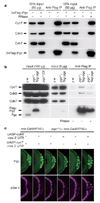Drosophila Pgc protein inhibits P-TEFb recruitment to chromatin in primordial germ cells
- PMID: 18200011
- PMCID: PMC2719856
- DOI: 10.1038/nature06498
Drosophila Pgc protein inhibits P-TEFb recruitment to chromatin in primordial germ cells
Abstract
Germ cells are the only cells that transmit genetic information to the next generation, and they therefore must be prevented from differentiating inappropriately into somatic cells. A common mechanism by which germline progenitors are protected from differentiation-inducing signals is a transient and global repression of RNA polymerase II (RNAPII)-dependent transcription. In both Drosophila and Caenorhabditis elegans embryos, the repression of messenger RNA transcription during germ cell specification correlates with an absence of phosphorylation of Ser 2 residues in the carboxy-terminal domain of RNAPII (hereafter called CTD), a critical modification for transcriptional elongation. Here we show that, in Drosophila embryos, a small protein encoded by polar granule component (pgc) is essential for repressing CTD Ser 2 phosphorylation in newly formed pole cells, the germline progenitors. Ectopic Pgc expression in somatic cells is sufficient to repress CTD Ser 2 phosphorylation. Furthermore, Pgc interacts, physically and genetically, with positive transcription elongation factor b (P-TEFb), the CTD Ser 2 kinase complex, and prevents its recruitment to transcription sites. These results indicate that Pgc is a cell-type-specific P-TEFb inhibitor that has a fundamental role in Drosophila germ cell specification. In C. elegans embryos, PIE-1 protein segregates to germline blastomeres, and is thought to repress mRNA transcription through interaction with P-TEFb. Thus, inhibition of P-TEFb is probably a common mechanism during germ cell specification in the disparate organisms C. elegans and Drosophila.
Figures




References
-
- Seydoux G, Braun RE. Pathway to totipotency: lessons from germ cells. Cell. 2006;127:891–904. - PubMed
-
- Seydoux G, Dunn MA. Transcriptionally repressed germ cells lack a subpopulation of phosphorylated RNA polymerase II in early embryos of Caenorhabditis elegans and Drosophila melanogaster. Development. 1997;124:2191–2201. - PubMed
-
- Saunders A, Core LJ, Lis JT. Breaking barriers to transcription elongation. Nature Rev. Mol. Cell Biol. 2006;7:557–567. - PubMed
-
- Seydoux G, et al. Repression of gene expression in the embryonic germ lineage of C. elegans. Nature. 1996;382:713–716. - PubMed
-
- Mello CC, et al. The PIE-1 protein and germline specification in C. elegans embryos. Nature. 1996;382:710–712. - PubMed
Publication types
MeSH terms
Substances
Grants and funding
LinkOut - more resources
Full Text Sources
Other Literature Sources
Molecular Biology Databases

